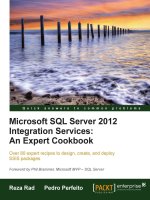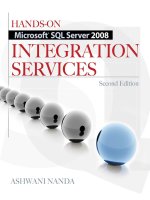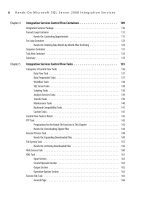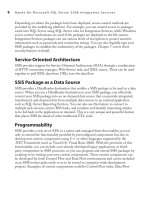Microsoft SQL Server 2012 Integration Services pptx
Bạn đang xem bản rút gọn của tài liệu. Xem và tải ngay bản đầy đủ của tài liệu tại đây (18.68 MB, 814 trang )
www.it-ebooks.info
www.it-ebooks.info
Programming Microsoft
®
SQL Server
®
2012
Leonard Lobel
Andrew Brust
www.it-ebooks.info
Published with the authorization of Microsoft Corporation by:
O’Reilly Media, Inc.
1005 Gravenstein Highway North
Sebastopol, California 95472
Copyright © 2012 by Sleek Technologies Inc., and Blue Badge Insights, Inc.
All rights reserved. No part of the contents of this book may be reproduced or transmitted in any form or by any
means without the written permission of the publisher.
ISBN: 978-0-7356-5822-6
1 2 3 4 5 6 7 8 9 M 7 6 5 4 3 2
Printed and bound in the United States of America.
Microsoft Press books are available through booksellers and distributors worldwide. If you need support related
to this book, email Microsoft Press Book Support at Please tell us what you think of
this book at
Microsoft and the trademarks listed at />Trademarks/EN-US.aspx are trademarks of the Microsoft group of companies. All other marks are property of
their respective owners.
The example companies, organizations, products, domain names, email addresses, logos, people, places, and
events depicted herein are ctitious. No association with any real company, organization, product, domain name,
email address, logo, person, place, or event is intended or should be inferred.
This book expresses the author’s views and opinions. The information contained in this book is provided without
any express, statutory, or implied warranties. Neither the authors, O’Reilly Media, Inc., Microsoft Corporation,
nor its resellers, or distributors will be held liable for any damages caused or alleged to be caused either directly
or indirectly by this book.
Acquisitions Editor: Russell Jones
Developmental Editor: Russell Jones
Production Editor: Melanie Yarbrough
Editorial Production: Christian Holdener, S4Carlisle Publishing Services
Technical Reviewer: John Paul Meuller
Copyeditor: Andrew Jones
Indexer: WordCo Indexing Services
Cover Design: Twist Creative • Seattle
Cover Composition: ContentWorks, Inc.
Illustrator: Rebecca Demarest
www.it-ebooks.info
To my partner, Mark, and our children, Adam, Jacqueline,
Joshua, and Sonny. With all my love, I thank you guys, for all of
yours.
— Leonard LobeL
For my three boys: Miles, Sean, and Aidan. And for my sister,
Valerie Hope.
— andrew brust
www.it-ebooks.info
www.it-ebooks.info
Contents at a Glance
Introduction xxi
PART I CORE SQL SERVER DEVELOPMENT
CHAPTER 1 Introducing SQL Server Data Tools 3
CHAPTER 2 T-SQL Enhancements 45
CHAPTER 3 Exploring SQL CLR 125
CHAPTER 4 Working with Transactions 169
CHAPTER 5 SQL Server Security 207
PART II GOING BEYOND RELATIONAL
CHAPTER 6 XML and the Relational Database 255
CHAPTER 7 Hierarchical Data and the Relational Database 299
CHAPTER 8 Native File Streaming 323
CHAPTER 9 Geospatial Support 367
PART III APPLIED SQL
CHAPTER 10 The Microsoft Data Access Juggernaut 427
CHAPTER 11 WCF Data Access Technologies 509
CHAPTER 12 Moving to the Cloud with SQL Azure 579
CHAPTER 13 SQL Azure Data Sync and
Windows Phone Development 619
CHAPTER 14 Pervasive Insight 675
CHAPTER 15 xVelocity In-Memory Technologies 701
Index 737
www.it-ebooks.info
www.it-ebooks.info
vii
What do you think of this book? We want to hear from you!
Microsoft is interested in hearing your feedback so we can continually improve our
books and learning resources for you. To participate in a brief online survey, please visit:
microsoft.com/learning/booksurvey
Contents
Introduction xxi
Acknowledgements xxxvii
PART I CORE SQL SERVER DEVELOPMENT
Chapter 1 Introducing SQL Server Data Tools 3
Introducing SSDT 4
Database Tooling Designed for Developers 4
Declarative, Model-Based Development 5
Connected Development 6
Disconnected Development 7
Versioning and Snapshots 8
Targeting Different Platforms 9
Working with SSDT 9
Connecting with SQL Server Object Explorer 10
Gathering New Requirements 16
Using the Table Designer (Connected) 17
Working Ofine with a SQL Server Database Project 22
Taking a Snapshot 25
Using the Table Designer (Ofine Database Project) 25
Introducing LocalDB 27
Refactoring the Database 31
Testing and Debugging. . . . . . . . . . . . . . . . . . . . . . . . . . . . . . . . . . . . . .33
Comparing Schemas 35
Publishing to SQL Azure 39
Adopting SSDT 42
Summary. . . . . . . . . . . . . . . . . . . . . . . . . . . . . . . . . . . . . . . . . . . . . . . . . . . . . . . .43
www.it-ebooks.info
viii Contents
Chapter 2 T-SQL Enhancements 45
Table-Valued Parameters 46
More Than Just Another Temporary Table Solution 46
Submitting Orders 47
Using TVPs for Bulk Inserts and Updates 49
Passing TVPs Using ADO.NET 52
Passing Collections to TVPs Using Custom Iterators 54
TVP Limitations 57
Date and Time Data Types 58
Separation of Dates and Times 58
More Portable Dates and Times 58
Time Zone Awareness 59
Date and Time Accuracy, Storage, and Format 60
Date and Time Functions 62
The MERGE Statement 65
Dening the Merge Source and Target 67
The WHEN MATCHED Clause 68
The WHEN NOT MATCHED BY TARGET Clause 69
Using MERGE for Table Replication 70
The WHEN NOT MATCHED BY SOURCE Clause 71
MERGE Output 73
Choosing a Join Method 74
MERGE DML Behavior 75
The INSERT OVER DML Syntax 76
A Filterable Alternative to OUTPUT…INTO 77
Consuming CHANGES 80
The GROUPING SETS Operator 83
Rolling Up by Level 85
Rolling Up All Level Combinations 86
Returning Just the Top Level 88
Mixing and Matching 89
Handling NULL Values 90
www.it-ebooks.info
Contents ix
Windowing (OVER Clause) Enhancements 93
Sliding Aggregations 96
Using RANGE versus ROWS 97
New T-SQL Functions in SQL Server 2012 97
New Analytic Functions 98
New Conversion Functions 103
New Date and Time Functions 104
New Logical Functions 106
New String Functions 107
Changed Mathematical Function 109
The THROW Statement 109
Re-Throwing Exceptions 110
Comparing THROW and RAISERROR 111
Server-Side Paging 113
Using ROW_NUMBER 113
Using OFFSET/FETCH NEXT 114
The SEQUENCE Object 115
Sequence Limitations 117
Metadata Discovery 118
Summary. . . . . . . . . . . . . . . . . . . . . . . . . . . . . . . . . . . . . . . . . . . . . . . . . . . . . . .122
Chapter 3 Exploring SQL CLR 125
Getting Started: Enabling CLR Integration 126
Visual Studio/SQL Server Integration 126
SQL Server Database Projects in Visual Studio 127
Automated Deployment 129
SQL CLR Code Attributes 129
Your First SQL CLR Stored Procedure 130
CLR Stored Procedures and Server-Side Data Access 132
Piping Data with SqlDataRecord and SqlMetaData 134
Deployment 136
www.it-ebooks.info
x Contents
Getting Ready 137
Deploying Your Assembly 138
Deploying Your Stored Procedures 141
Testing Your Stored Procedures 142
CLR Functions 143
CLR Triggers 148
CLR Aggregates 151
SQL CLR Types 156
Security 161
Examining and Managing CLR Types in a Database 162
Best Practices for SQL CLR Usage 168
Summary. . . . . . . . . . . . . . . . . . . . . . . . . . . . . . . . . . . . . . . . . . . . . . . . . . . . . . .168
Chapter 4 Working with Transactions 169
What Is a Transaction? 170
Understanding the ACID Properties 170
Local Transaction Support in SQL Server 172
Autocommit Transaction Mode 173
Explicit Transaction Mode. . . . . . . . . . . . . . . . . . . . . . . . . . . . . . . . . . .173
Implicit Transaction Mode 176
Batch-Scoped Transaction Mode 176
Isolation Levels 179
Read Uncommitted Isolation Level 179
Read Committed Isolation Level 181
Repeatable Read Isolation Level 182
Serializable Isolation Level 182
Snapshot Isolation Level 182
Read Committed Snapshot Isolation Level 183
Isolation Levels in ADO.NET 184
Distributed Transactions 186
Distributed Transaction Terminology 186
Rules and Methods of Enlistment 187
Distributed Transactions in SQL Server 189
www.it-ebooks.info
Contents xi
Distributed Transactions in the .NET Framework 190
Using a Resource Manager in a Successful Transaction 198
Transactions in SQL CLR (CLR Integration) 201
Putting It All Together 204
Summary. . . . . . . . . . . . . . . . . . . . . . . . . . . . . . . . . . . . . . . . . . . . . . . . . . . . . . .206
Chapter 5 SQL Server Security 207
Four Themes of the Security Framework 208
Secure by Design 208
Secure by Default 208
Secure by Deployment 208
Secure Communications 208
SQL Server Security Overview 209
SQL Server Logins 210
Database Users 211
The guest User Account 212
Authentication and Authorization 213
How Clients Establish a Connection 213
Password Policies 215
User-Schema Separation 216
Execution Context 218
Encryption Support 222
Encrypting Data on the Move 223
Encrypting Data at Rest. . . . . . . . . . . . . . . . . . . . . . . . . . . . . . . . . . . . .224
Transparent Data Encryption 229
SQL Server Audit 234
Creating an Audit Object 235
Auditing Options 236
Recording Audits to the File System 238
Recording Audits to the Windows Event Log 239
Auditing Server Events 239
Auditing Database Events 240
Viewing Audited Events 242
Querying Audit Catalog Views 244
www.it-ebooks.info
xii Contents
Partially Contained Databases 244
Creating a Partially Contained Database 245
Creating a Contained User 245
Other Partially Contained Database Features 246
How Hackers Attack SQL Server 249
Direct Connection to the Internet 249
Weak System Administrator Account Passwords 249
SQL Server Browser Service 249
SQL Injection 250
Intelligent Observation 250
Summary. . . . . . . . . . . . . . . . . . . . . . . . . . . . . . . . . . . . . . . . . . . . . . . . . . . . . . .251
PART II GOING BEYOND RELATIONAL
Chapter 6 XML and the Relational Database 255
Character Data as XML 256
The xml Data Type 257
Working with the xml Data Type as a Variable 257
Working with XML in Tables 258
XML Schema Denitions (XSDs) 259
XML Indexes 266
FOR XML Commands 268
FOR XML RAW 269
FOR XML AUTO 269
FOR XML EXPLICIT 271
Additional FOR XML Features 276
The TYPE Option 276
FOR XML PATH 277
Emitting a ROOT Element 280
Producing an Inline XSD Schema 281
Producing Element-Based XML 282
Shredding XML Using OPENXML 284
Querying XML Data Using XQuery 285
Understanding XQuery Expressions and XPath 285
www.it-ebooks.info
Contents xiii
SQL Server XQuery in Action 288
XML DML 296
Summary. . . . . . . . . . . . . . . . . . . . . . . . . . . . . . . . . . . . . . . . . . . . . . . . . . . . . . .298
Chapter 7 Hierarchical Data and the Relational Database 299
The hierarchyid Data Type 300
Creating a Hierarchical Table 301
The GetLevel Method 302
Populating the Hierarchy 303
The GetRoot Method 303
The GetDescendant Method 304
The ToString Method 305
The GetAncestor Method 310
Hierarchical Table Indexing Strategies 313
Depth-First Indexing 314
Breadth-First Indexing 314
Querying Hierarchical Tables 315
The IsDescendantOf Method 315
Reordering Nodes within the Hierarchy 317
The GetReparentedValue Method 318
Transplanting Subtrees 319
More hierarchyid Methods 321
Summary. . . . . . . . . . . . . . . . . . . . . . . . . . . . . . . . . . . . . . . . . . . . . . . . . . . . . . .322
Chapter 8 Native File Streaming 323
Traditional BLOB Strategies 323
BLOBs in the Database 324
BLOBs in the File System 324
Introducing FILESTREAM 325
Enabling FILESTREAM 326
Enabling FILESTREAM for the Machine 326
Enabling FILESTREAM for the Server Instance 328
www.it-ebooks.info
xiv Contents
Creating a FILESTREAM-Enabled Database 329
Creating a Table with FILESTREAM Columns 330
Storing and Retrieving FILESTREAM Data. . . . . . . . . . . . . . . . . . . . . . . . . . .331
Deleting FILESTREAM Data 334
Direct Streaming in .NET with SqlFileStream 335
Understanding SqlFileStream 335
Building the Windows Forms Client 337
Programming SqlFileStream Data Access. . . . . . . . . . . . . . . . . . . . . .338
Creating a Streaming HTTP Service 348
Building a WPF Client 352
FILESTREAM Limitations and Considerations 355
Introducing FileTable 357
Creating a FileTable 360
Manipulating a FileTable 362
Searching Documents 365
Summary. . . . . . . . . . . . . . . . . . . . . . . . . . . . . . . . . . . . . . . . . . . . . . . . . . . . . . .366
Chapter 9 Geospatial Support 367
SQL Server Spaces Out 367
Spatial Models 368
Planar (Flat-Earth) Model 368
Geodetic (Ellipsoidal Sphere) Model 368
Spatial Data Standards 370
Importing Well-Known Text (WKT) 370
Importing WKB 373
Importing Geography Markup Language (GML) 374
Spatial Data Types 374
Working with geometry 375
Working with geography. . . . . . . . . . . . . . . . . . . . . . . . . . . . . . . . . . . .388
Spatial Enhancements in SQL Server 2012 400
New Spatial Data Classes 401
New Spatial Methods 405
Other Enhancements 411
www.it-ebooks.info
Contents xv
Integrating with Microsoft Bing Maps 413
Summary. . . . . . . . . . . . . . . . . . . . . . . . . . . . . . . . . . . . . . . . . . . . . . . . . . . . . . .423
PART III APPLIED SQL
Chapter 10 The Microsoft Data Access Juggernaut 427
.NET Data Access Evolution 427
Preparing the Sample Database 430
Monitoring Database Activity with SQL Server Proler 435
Conventional ADO.NET 436
Using the Raw Data Access Objects 436
Working with DataSets 455
Language-Integrated Query (LINQ) 472
LINQ to DataSet 473
Object Relational Modeling (ORM) Comes to .NET 477
Multiple ORM Offerings from Redmond 479
LINQ to SQL: Then and Now 479
Entity Framework: Now and in the Future 482
Summary. . . . . . . . . . . . . . . . . . . . . . . . . . . . . . . . . . . . . . . . . . . . . . . . . . . . . . .508
Chapter 11 WCF Data Access Technologies 509
Dening Services 509
WCF Data Access Options 510
WCF Data Services 511
Building a WCF Data Service 512
Creating the Entity Data Model 513
Testing WCF Data Services with Internet Explorer 515
Building Client Applications for WCF Data Services 518
Extending WCF Data Services 544
WCF RIA Services. . . . . . . . . . . . . . . . . . . . . . . . . . . . . . . . . . . . . . . . . . . . . . . .548
Establishing a WCF RIA Services Link 549
Creating the Entity Data Model 551
Building the Domain Service and Metadata Classes 552
Building the Silverlight Client 561
www.it-ebooks.info
xvi Contents
Inspecting the .NET Framing Protocol with Fiddler 569
Testing the Complete WCF RIA Services Solution 569
Making the Right WCF Data Access Choice 577
Summary. . . . . . . . . . . . . . . . . . . . . . . . . . . . . . . . . . . . . . . . . . . . . . . . . . . . . . .578
Chapter 12 Moving to the Cloud with
SQL Azure 579
History 581
But What Is SQL Azure? 581
Why the Limitations? 582
Pricing 583
The First One’s Free 583
Getting Set Up 584
Beyond the Prerequisites 585
Provisioning Your Server 586
Provisioning Your Database 589
Managing Your Database 589
Creating Tables and Entering Data 590
Querying in the Browser 592
Index Design 592
Management and Visualizations 593
Connecting from Down Below 596
Migrating and Syncing Between Earth and Cloud 599
DACPACs to the Rescue 600
Extract, Deploy, Export, and Import DAC les 600
Scenarios 602
SQL Azure Federations 607
A SQL Azure Federations Lexicon 607
Creating a Federation 608
Federated Tables 609
Using a Federation Member 610
Splitting and Dropping Federation Members 610
Central Tables and Reference Tables 610
Fan-Out Queries and Multi-Tenancy 611
www.it-ebooks.info
Contents xvii
Federations Support in SSMS and SSDT 611
Federations Make Sense in the Cloud 612
SQL Azure Reporting 612
Provisioning 613
Report Authoring 614
Deploying Reports 615
Getting Your Bearings 617
Summary. . . . . . . . . . . . . . . . . . . . . . . . . . . . . . . . . . . . . . . . . . . . . . . . . . . . . . .617
Chapter 13 SQL Azure Data Sync and
Windows Phone 7 Development 619
Characteristics of an Occasionally Connected System 620
Data Management 620
Getting to Know SQL Azure Data Sync 621
Capabilities and Features 621
Data Sync Terminology 622
Sync Groups 623
The Client Sync Agent 624
SQL Azure Data Sync Considerations 625
Creating an Occasionally Connected System 626
Prerequisites 629
Conguring SQL Azure Data Sync 630
Provisioning the SQL Azure Data Sync Server 630
Creating the Sync Group 631
Hosting WCF Data Services in Windows Azure 641
About Windows Azure 641
Creating the FlixPoll Solution 642
Adding the FlixPoll Data Service 643
Adding the Entity Data Model 644
Creating the FlixPoll Client 647
Consuming OData on Windows Phone 662
SQL Server on the Phone 666
Deploying to Windows Azure 672
Summary. . . . . . . . . . . . . . . . . . . . . . . . . . . . . . . . . . . . . . . . . . . . . . . . . . . . . . .674
www.it-ebooks.info
xviii Contents
Chapter 14 Pervasive Insight 675
The Microsoft BI Stack: What’s It All About? 676
Master Data Services 677
Data Quality Services 680
Integration Services 681
SQL Server RDBMS, Fast Track DW, and SQL Server PDW 683
Data Marts and Data Warehouses 683
The Star Schema 684
SQL Server Data Warehouse Appliances 684
Analysis Services 686
The Multidimensional Engine 686
PowerPivot and SSAS Tabular Mode 687
Data Mining 690
Power View 691
Reporting Services 692
Report Parts 693
Alerting 693
Dashboard Components 694
Excel and Excel Services 694
Using Excel Services 694
PerformancePoint Services 696
StreamInsight 697
SQL Server Editions and SharePoint Version Requirements 697
Summary. . . . . . . . . . . . . . . . . . . . . . . . . . . . . . . . . . . . . . . . . . . . . . . . . . . . . . .699
Chapter 15 xVelocity In-Memory Technologies 701
Column Store Databases 702
Column Store Tech in the BI Industry 703
xVelocity in the RDBMS: Columnstore Indexes 704
Building a Columnstore Index 704
What You Can’t Do 704
How Columnstore Indexes Work 706
www.it-ebooks.info
Contents xix
xVelocity for Analysis: PowerPivot and SSAS Tabular Models 709
Clearing Up the Analysis Services Vocabulary 710
The Lowdown on BISM 711
Friends, Countrymen, Bring Me Your Data 711
Building the BISM 712
Dial M for Modeling 715
Modeling, Part Deux 718
Querying in Excel 724
PowerPivot for SharePoint 726
Moving to SSAS Tabular 727
Power View Here We Come 732
Welcome Back to VertiPaq 734
Summary. . . . . . . . . . . . . . . . . . . . . . . . . . . . . . . . . . . . . . . . . . . . . . . . . . . . . . .735
Index 737
About the Authors 773
What do you think of this book? We want to hear from you!
Microsoft is interested in hearing your feedback so we can continually improve our
books and learning resources for you. To participate in a brief online survey, please visit:
microsoft.com/learning/booksurvey
www.it-ebooks.info
www.it-ebooks.info
xxi
Introduction
—Leonard Lobel
W
elcome! This is a book about Microsoft SQL Server 2012 written just for you, the
developer. Whether you are programming against SQL Server directly at the
database level or further up the stack using Microsoft .NET, this book shows you the way.
The latest release of Microsoft’s agship database product delivers an unprecedented,
highly scalable data platform capable of handling the most demanding tasks and
workloads. As with every release, SQL Server 2012 adds many new features and
enhancements for developers, administrators, and (increasingly) end users alike. Col-
lectively, these product enhancements reinforce—and advance—SQL Server’s position
as a prominent contender in the industry. As the product continues to evolve, its stack of
offerings continues to expand. And as the complete SQL Server stack is too large for any
one book to cover effectively, our emphasis in this book is on programmability. Specically,
we explore the plethora of ways in which SQL Server (and its cloud cousin, Microsoft SQL
Azure) can be programmed for building custom applications and services.
How Signicant Is the SQL Server 2012 Release?
SQL Server, particularly its relational database engine, matured quite some time ago.
So the “signicance” of every new release over recent years can be viewed—in some
ways—as relatively nominal. The last watershed release of the product was actually
SQL Server 2005, which was when the relational engine (that, for years, dened SQL
Server) stopped occupying “center stage,” and instead took its position alongside a
set of services that today, collectively, dene the product. These include the Business
Intelligence (BI) components Reporting Services, Analysis Services, and Integration
Services—features that began appearing as early as 1999 but, prior to SQL Server
2005, were integrated sporadically as a patchwork of loosely coupled add-ons,
wizards, and management consoles. SQL Server 2005 changed all that with a complete
overhaul. For the rst time, the overall SQL Server product delivered a broader, richer,
and more consolidated set of features and services which are built into—rather than
bolted onto—the platform. None of the product versions that have been released
since that time—SQL Server 2008, 2008 R2, and now 2012—have changed underlying
architecture this radically.
That said, each SQL Server release continues to advance itself in vitally signicant
ways. SQL Server 2008 (released August 6, 2008) added a host of new features to the
www.it-ebooks.info
xxii Introduction
relational engine—T-SQL enhancements, Change Data Capture (CDC), Transparent Data
Encryption (TDE), SQL Audit, FILESTREAM—plus powerful BI capabilities with Excel
PivotTables, charts, and CUBE formulas. SQL Server 2008 R2 (released April 21, 2010),
internally dubbed the “BI Refresh” while in development, added a revamped version of
Reporting Services as well as PowerPivot for Excel and SharePoint, Master Data Services,
and StreamInsight, but offered little more than minor tweaks and xes to the relational
engine.
The newest release—SQL Server 2012—ofcially launched on March 7, 2012.
Like every new release, this version improves on all of the key “abilities” (availability,
scalability, manageability, programmability, and so on). Among the chief reliability
improvements is the new High Availability Disaster Recovery (HADR) alternative to
database mirroring. HADR (also commonly known as “Always On”) utilizes multiple
secondary servers in an “availability group” for scale-out read-only operations (rather
than forcing them to sit idle, just waiting for a failover to occur). Multisubnet failover
clustering is another notable new manageability feature.
SQL Server 2012 adds many new features to the relational engine, most of which
are covered in this book. There are powerful T-SQL extensions, most notably the
windowing enhancements, plus 22 new T-SQL functions, improved error handling,
server-side paging, sequence generators, rich metadata discovery techniques, and
contained databases. There are also remarkable improvements for unstructured data,
such as the FileTable abstraction over FILESTREAM and the Windows le system API,
full-text property searching, and Statistical Semantic Search. Spatial support gets a
big boost as well, with support for circular data, full-globe support, increased perfor-
mance, and greater parity between the geometry and geography data types. And new
“ columnstore” technology drastically increases performance of extremely large cubes
(xVelocity for PowerPivot and Analysis Services) and data warehouses (using an xVeloci-
ty-like implementation in the relational engine).
The aforementioned relational engine features are impressive, but still amount to lit-
tle more than “additives” over an already established database platform. A new release
needs more than just extra icing on the cake for customers to perceive an upgrade as
compelling. To that end, Microsoft has invested heavily in BI with SQL Server 2012, and
the effort shows. The BI portion of the stack has been expanded greatly, delivering key
advances in “pervasive insight.” This includes major updates to the product’s analytics,
data visualization (such as self-service reporting with Power View), and master data
management capabilities, as well Data Quality Services (DQS), a brand new data quality
engine. There is also a new Business Intelligence edition of the product that includes
all of these capabilities without requiring a full Enterprise edition license. Finally, SQL
Server Data Tools (SSDT) brings brand new database tooling inside Visual Studio. SSDT
www.it-ebooks.info
Introduction xxiii
provides a declarative, model-based design-time experience for developing databases
while connected, ofine, on-premise, or in the cloud.
Who Should Read This Book
This book is intended for developers who have a basic knowledge of relational
database terms and principles.
Assumptions
In tailoring the content of this book, there are a few assumptions that we make
about you. First, we expect that you are a developer who is already knowledgeable
about relational database concepts—whether that experience is with SQL Server or
non-Microsoft platforms. As such, you already know about tables, views, primary and
foreign keys (relationships), stored procedures, user-dened functions, and triggers.
These essentials are assumed knowledge and are not covered in this book. Similarly, we
don’t explain proper relational design, rules of data normalization, strategic indexing
practices, how to express basic queries, and other relational fundamentals. We also
assume that you have at least basic familiarity with SQL statement syntax—again, either
T-SQL in SQL Server or SQL dialects in other platforms—and have a basic working
knowledge of .NET programming in C# on the client.
Having said all that, we have a fairly liberal policy regarding these prerequisites. For
example, if you’ve only dabbled with T-SQL or you’re more comfortable with Microsoft
Visual Basic .NET than C#, that’s okay, as long as you’re willing to try and pick up on
things as you read along. Most of our code samples are not that complex. However, our
explanations assume some basic knowledge on your part, and you might need to do a
little research if you lack the experience.
Note For the sake of consistency, all the .NET code in this book is written
in C#. However, this book is in no way C#-oriented, and there is certainly
nothing C#-specic in the .NET code provided. As we just stated, the code
samples are not very complex, and if you are more experienced with Visual
Basic .NET than you are with C#, you should have no trouble translating the
C# code to Visual Basic .NET on the y as you read it.
With that baseline established, our approach has been to add value to the SQL
Server documentation by providing a developer-oriented investigation of its features,
www.it-ebooks.info









